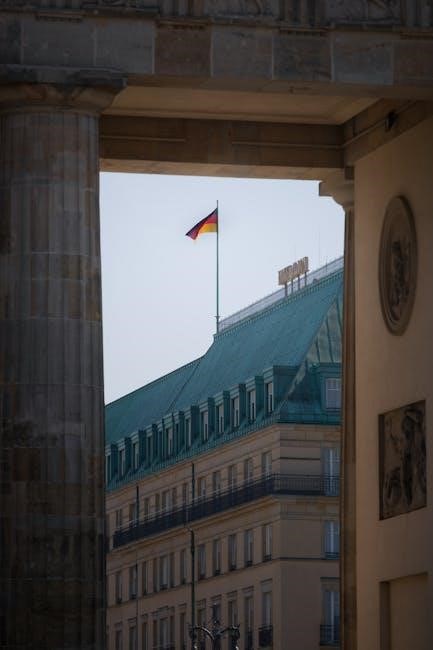The 1973 Petrodollar Agreement was a landmark informal arrangement between the United States and Saudi Arabia, establishing oil pricing in US dollars and investments in US assets.

Historical Context of the 1973 Petrodollar Agreement
The 1973 agreement emerged amid the oil crisis, with the US offering military protection to Saudi Arabia in exchange for oil sales exclusively in US dollars.
The 1973 Oil Crisis and Its Impact
The 1973 Oil Crisis, triggered by Saudi Arabia cutting off oil shipments to the US during the Arab-Israeli War, caused global oil prices to surge. This embargo, led by OAPEC, was a response to US support for Israel, significantly disrupting the global economy. The crisis highlighted the vulnerability of oil-dependent nations and prompted the US to seek strategic alliances, ultimately leading to the Petrodollar Agreement with Saudi Arabia. This event reshaped global economic and geopolitical dynamics.
Nixon Administration’s Strategy and Saudi Arabia
The Nixon Administration’s strategy during the 1973 oil crisis focused on securing a geopolitical alliance with Saudi Arabia. The US sought to stabilize the global economy by ensuring oil exports were priced exclusively in US dollars, reinforcing the dollar’s dominance. In exchange, Saudi Arabia received military protection and investment opportunities in US assets. This strategic partnership aimed to counterbalance economic instability and strengthen US influence in the Middle East.
Key Terms and Conditions of the Agreement
The 1973 agreement required Saudi Arabia to price oil in US dollars and invest surplus revenues in US securities, ensuring dollar dominance and economic stability.
Pricing Oil Exclusively in US Dollars
The 1973 agreement mandated that Saudi Arabia sell its oil exclusively in US dollars, a cornerstone of the petrodollar system. This exclusivity ensured consistent global demand for the US dollar, solidifying its position as the world’s dominant reserve currency. The arrangement required oil-producing nations to adopt the dollar for all oil transactions, creating a stable financial framework that benefited both the US economy and Saudi Arabia. This pricing mechanism became a critical component of international trade, reinforcing the dollar’s global influence and tying oil-producing countries financially to the United States.
Saudi Arabia’s Investment in US Treasury Securities
Under the 1973 agreement, Saudi Arabia agreed to reinvest its oil revenue surpluses into US Treasury securities and other assets. This petrodollar recycling mechanism ensured that the kingdom’s wealth remained tied to the US economy. By purchasing US debt, Saudi Arabia supported the stability of the US dollar while securing a safe and lucrative investment destination. This financial arrangement bolstered the US economy and reinforced the global dominance of the dollar, creating a symbiotic relationship that benefited both nations for decades.

Economic Impact of the Petrodollar System
The Petrodollar Agreement established the US dollar as the global reserve currency, ensuring its stability and dominance. It linked oil exports to dollar strength, boosting the US economy.
Rise of the US Dollar as a Global Reserve Currency
The Petrodollar Agreement solidified the US dollar’s dominance as the world’s primary reserve currency. By requiring oil sales to be priced in dollars, global demand for the currency surged. This arrangement ensured the dollar’s stability and reinforced its role in international trade. The recycling of petrodollars through US financial markets further bolstered the economy, cementing the dollar’s position as the global standard for trade and reserves, reshaping international finance forever.
Petrodollar Recycling and Its Mechanism
Petrodollar recycling refers to the process where oil-exporting nations reinvest their dollar earnings from oil sales into US financial assets, such as Treasury securities. This mechanism ensured a steady demand for the US dollar, maintaining its strength. The surplus funds from oil revenues were channeled back into the US economy, fostering financial stability. This system not only bolstered the dollar’s global dominance but also created a symbiotic relationship between oil producers and the US financial markets, ensuring mutual economic benefits and geopolitical alignment.
Geopolitical Implications of the Agreement
The 1973 Petrodollar Agreement reinforced US-Saudi ties, solidifying US influence in the Middle East and ensuring oil supply stability, while countering Soviet geopolitical ambitions.
US-Saudi Arabia Partnership and Global Influence
The 1973 agreement deepened the US-Saudi partnership, ensuring oil exports were priced in dollars, bolstering the US economy and its global influence. This alliance provided the US with strategic stability in the Middle East, while Saudi Arabia gained military protection and economic ties. The partnership solidified the US dollar’s dominance as a global reserve currency and enhanced both nations’ geopolitical standing, shaping international relations for decades.
Shift in Global Financial Dynamics Post-1973
The 1973 Petrodollar Agreement reshaped global financial dynamics by establishing the US dollar as the primary currency for oil transactions. This created consistent demand for dollars worldwide, reinforcing its status as the global reserve currency. The agreement also influenced international trade patterns, as nations sought to hold dollars to purchase oil, further entrenching US economic dominance. This shift solidified the dollar’s central role in global finance, impacting monetary policies and trade balances across nations.
Role of OPEC in the Petrodollar System
OPEC’s 1973 decision to sell oil exclusively in US dollars was central to the Petrodollar System, ensuring global demand for the dollar and its dominance in international trade.
OPEC’s Decision to Sell Oil in US Dollars
In 1973, OPEC, led by Saudi Arabia, agreed to sell oil exclusively in US dollars, a decision that became a cornerstone of the Petrodollar Agreement. This move ensured that global oil transactions would bolster the US dollar’s stability and demand, solidifying its position as the world’s reserve currency. The arrangement tied oil-exporting nations’ economic interests to the US, creating a mutually beneficial relationship that influenced global energy markets and reinforced US geopolitical and economic dominance for decades.
Impact of OPEC’s Policies on Global Markets
OPEC’s decision to price oil in US dollars reshaped global markets by centralizing the dollar’s role in international trade. This policy stabilized the dollar’s value, making it the preferred currency for oil transactions. Consequently, other nations accumulated dollars to purchase oil, reinforcing the dollar’s dominance. This system also influenced inflation rates and monetary policies worldwide, as oil price fluctuations had far-reaching economic effects. The Petrodollar system thus became a cornerstone of global economic stability, tightly linking energy markets to US financial power.

The 2024 Expiration of the Petrodollar Agreement
The Petrodollar Agreement expired on June 9, 2024, ending a 50-year informal arrangement. This marked a significant shift in global financial and geopolitical landscapes.
End of the 50-Year Informal Arrangement
The 50-year Petrodollar Agreement expired on June 9, 2024, marking the end of a historic informal arrangement between the US and Saudi Arabia. This milestone signifies a major shift in global financial power dynamics, as the agreement had upheld the US dollar’s dominance in oil transactions since 1973. The expiration underscores changing geopolitical alliances and economic strategies, particularly Saudi Arabia’s decision not to renew the deal. This move reflects evolving global markets and the kingdom’s diversification efforts, raising uncertainties about the future of dollar dominance in energy trade.
Potential Shifts in Global Financial Power
The expiration of the Petrodollar Agreement in 2024 could trigger significant shifts in global financial power. The end of this arrangement may weaken the US dollar’s dominance in international trade, particularly in energy markets. Emerging economies and alternative currencies, such as the euro or yuan, could gain prominence. This transition may also elevate the influence of oil-producing nations like Saudi Arabia, as they explore new economic partnerships and diversify their investments beyond US assets. The global financial landscape could become more decentralized, reshaping economic hierarchies and alliances worldwide.
Challenges and Shifts Away from the Petrodollar
The Petrodollar system faces challenges as global demand for US dollars may decline, potentially weakening its dominance in international trade and energy pricing.
Rising Competition from Other Currencies
The Petrodollar system faces increasing competition as other currencies, such as the euro, yuan, and cryptocurrencies, gain prominence in global energy trade. China, Russia, and India are exploring alternative payment methods, reducing reliance on the US dollar for oil transactions. This shift threatens the dollar’s dominance and could weaken its global reserve currency status. Additionally, regional currencies are gaining traction, further diversifying international trade and diminishing the Petrodollar’s influence in the global economy.
Saudi Arabia’s Diversification Strategies
Saudi Arabia is diversifying its economy to reduce dependence on oil exports, investing in sectors like renewable energy, tourism, and infrastructure. The Vision 2030 plan aims to modernize the economy, attract foreign investment, and enhance private-sector growth. By expanding its economic base, Saudi Arabia seeks to mitigate risks tied to the Petrodollar system’s decline, ensuring long-term financial stability and global influence beyond its traditional oil-driven partnerships.

Future Outlook and Implications
The expiration of the Petrodollar Agreement in 2024 could reshape global financial dynamics, potentially weakening the US dollar’s dominance and altering international trade relationships.
Possible Repercussions on the US Economy
The expiration of the Petrodollar Agreement could reduce global demand for the US dollar, potentially weakening its value and increasing inflation. Reduced investments in US Treasury securities by Saudi Arabia and other oil exporters might strain federal finances. This shift could also elevate borrowing costs, impacting economic growth and stability. Additionally, the loss of petrodollar recycling could diminish the dollar’s dominance as the global reserve currency, reshaping international trade dynamics and financial markets. These changes could pose significant challenges for the US economy and global monetary systems.
Emerging Alternatives to the Petrodollar System
The expiration of the Petrodollar Agreement has spurred the exploration of alternative payment systems. Countries like China and Russia are promoting the use of their currencies for oil transactions, while others consider digital currencies or commodity-backed alternatives. Additionally, regional currency arrangements and blockchain-based solutions are gaining traction. These shifts aim to reduce dependency on the US dollar and create more decentralized global financial systems. Such changes could significantly alter the dynamics of international trade and energy markets, offering nations greater financial autonomy and diversification in their economic strategies.
